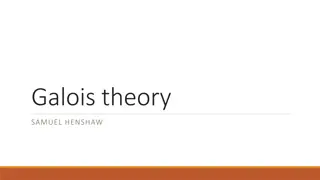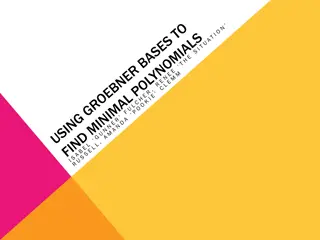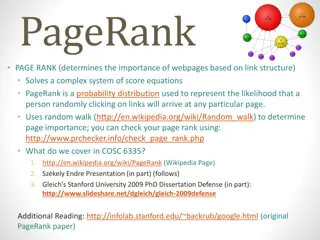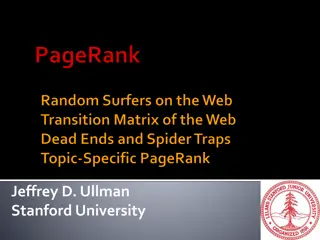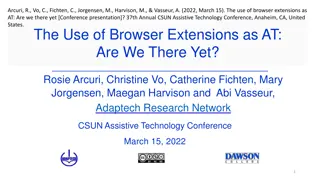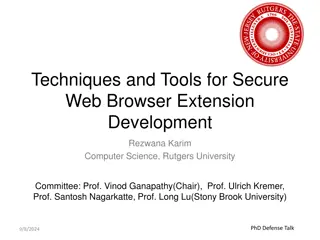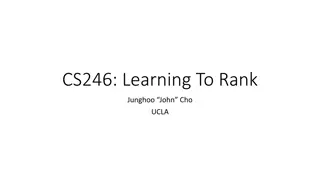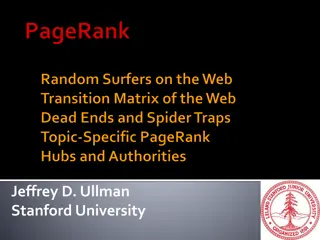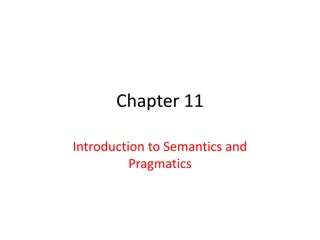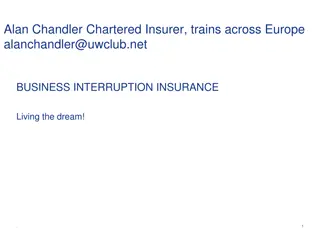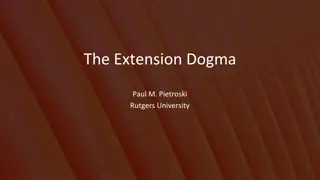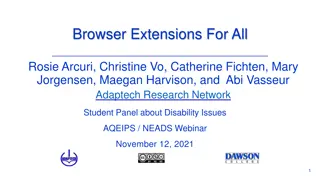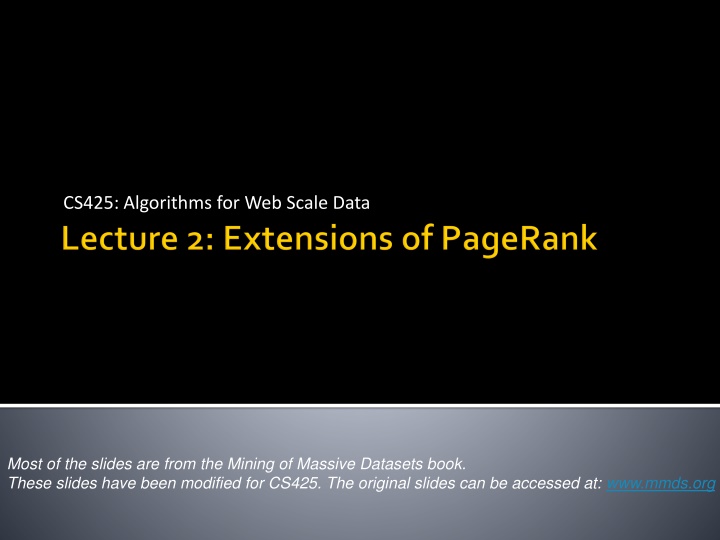
Algorithms for Web Scale Data: Optimizing Page Popularity and User Interests
Explore the concepts of Topic-Specific PageRank and TrustRank in managing page popularity, addressing link spam, and distinguishing topics for user interests. Dive into the methods of measuring popularity within specific topics and enhancing search queries based on user preferences. Learn about random walker teleportation and updating the PageRank formulation to encompass topic relevance effectively.
Download Presentation

Please find below an Image/Link to download the presentation.
The content on the website is provided AS IS for your information and personal use only. It may not be sold, licensed, or shared on other websites without obtaining consent from the author. If you encounter any issues during the download, it is possible that the publisher has removed the file from their server.
You are allowed to download the files provided on this website for personal or commercial use, subject to the condition that they are used lawfully. All files are the property of their respective owners.
The content on the website is provided AS IS for your information and personal use only. It may not be sold, licensed, or shared on other websites without obtaining consent from the author.
E N D
Presentation Transcript
CS425: Algorithms for Web Scale Data Most of the slides are from the Mining of Massive Datasets book. These slides have been modified for CS425. The original slides can be accessed at: www.mmds.org
Measures generic popularity of a page Will ignore/miss topic-specific authorities Solution: Topic-Specific PageRank (next) Susceptible to Link spam Artificial link topographies created in order to boost page rank Solution: TrustRank Uses a single measure of importance Other models of importance Solution: Hubs-and-Authorities J. Leskovec, A. Rajaraman, J. Ullman: Mining of Massive Datasets, http://www.mmds.org 2
Instead of generic popularity, can we measure popularity within a topic? Goal: Evaluate Web pages not just according to their popularity, but by how close they are to a particular topic, e.g. sports or history Allows search queries to be answered based on interests of the user Example: Query Trojan wants different pages depending on whether you are interested in sports, history and computer security J. Leskovec, A. Rajaraman, J. Ullman: Mining of Massive Datasets, http://www.mmds.org 4
Random walker has a small probability of teleporting at any step Teleport can go to: Standard PageRank: Any page with equal probability To avoid dead-end and spider-trap problems Topic Specific PageRank: A topic-specific set of relevant pages (teleport set) Idea: Bias the random walk When walker teleports, she pick a page from a set S S contains only pages that are relevant to the topic E.g., Open Directory (DMOZ) pages for a given topic/query For each teleport set S, we get a different vector rS J. Leskovec, A. Rajaraman, J. Ullman: Mining of Massive Datasets, http://www.mmds.org 5
To make this work all we need is to update the teleportation part of the PageRank formulation: ??? = ? ???+ (? ?)/|?|if ? ? ? ???+ ?otherwise A is stochastic! We weighted all pages in the teleport set S equally Could also assign different weights to pages! Compute as for regular PageRank: Multiply by M, then add a vector Maintains sparseness J. Leskovec, A. Rajaraman, J. Ullman: Mining of Massive Datasets, http://www.mmds.org 6
Suppose S = {1}, = 0.8 0.2 1 0.5 Node 1 2 3 4 Iteration 0 0.25 0.25 0.25 0.25 0.5 0.4 1 0.4 0.1 0.3 0.2 2 stable 0.28 0.16 0.32 0.24 0.4 0.294 0.118 0.327 0.261 1 2 3 0.8 1 1 0.8 0.8 4 S={1,2,3,4}, =0.8: r=[0.13, 0.10, 0.39, 0.36] S={1,2,3} , =0.8: r=[0.17, 0.13, 0.38, 0.30] S={1,2} , =0.8: r=[0.26, 0.20, 0.29, 0.23] S={1} , =0.8: r=[0.29, 0.11, 0.32, 0.26] S={1}, =0.90: r=[0.17, 0.07, 0.40, 0.36] S={1} , =0.8: r=[0.29, 0.11, 0.32, 0.26] S={1}, =0.70: r=[0.39, 0.14, 0.27, 0.19] J. Leskovec, A. Rajaraman, J. Ullman: Mining of Massive Datasets, http://www.mmds.org 7
Create different PageRanks for different topics The 16 DMOZ top-level categories: arts, business, sports, Which topic ranking to use? User can pick from a menu Classify query into a topic Can use the context of the query E.g., query is launched from a web page talking about a known topic History of queries e.g., basketball followed by Jordan User context, e.g., user s bookmarks, J. Leskovec, A. Rajaraman, J. Ullman: Mining of Massive Datasets, http://www.mmds.org 8
[Tong-Faloutsos, 06] I 1 J 1 1 A 1 H 1 B 1 1 D 1 1 1 E G F a.k.a.: Relevance, Closeness, Similarity J. Leskovec, A. Rajaraman, J. Ullman: Mining of Massive Datasets, http://www.mmds.org 10
Shortest path is not good: No effect of degree-1 nodes (E, F, G)! Multi-faceted relationships J. Leskovec, A. Rajaraman, J. Ullman: Mining of Massive Datasets, http://www.mmds.org 11
[Tong-Faloutsos, 06] I 1 J 1 1 A 1 H 1 B Multiple connections 1 1 D Quality of connection Direct & Indirect 1 1 1 E G connections F Length, Degree, Weight J. Leskovec, A. Rajaraman, J. Ullman: Mining of Massive Datasets, http://www.mmds.org 12
SimRank: Random walks from a fixed node Topic Specific PageRank from node u: teleport set S = {u} Resulting scores measures similarity to node u Problem: Must be done once for each node u Suitable for sub-Web-scale applications J. Leskovec, A. Rajaraman, J. Ullman: Mining of Massive Datasets, http://www.mmds.org 13
IJCAI Q: What is most related conference to ICDM? Philip S. Yu KDD Ning Zhong ICDM A:Topic-Specific PageRank with teleport set S={ICDM} R. Ramakrishnan SDM M. Jordan AAAI NIPS Conference Author J. Leskovec, A. Rajaraman, J. Ullman: Mining of Massive Datasets, http://www.mmds.org 14
PKDD SDM PAKDD 0.008 0.007 0.009 KDD ICML 0.005 0.011 ICDM 0.005 0.004 CIKM ICDE 0.005 0.004 0.004 ECML SIGMOD DMKD J. Leskovec, A. Rajaraman, J. Ullman: Mining of Massive Datasets, http://www.mmds.org 15
Normal PageRank: Teleports uniformly at random to any node All nodes have the same probability of surfer landing there: S = [0.1, 0.1, 0.1, 0.1, 0.1, 0.1, 0.1, 0.1, 0.1, 0.1] Topic-Specific PageRank also known as Personalized PageRank: Teleports to a topic specific set of pages Nodes can have different probabilities of surfer landing there: S = [0.1, 0, 0, 0.2, 0, 0, 0.5, 0, 0, 0.2] Random Walk with Restarts: Topic-Specific PageRank where teleport is always to the same node. S=[0, 0, 0, 0, 1, 0, 0, 0, 0, 0, 0] J. Leskovec, A. Rajaraman, J. Ullman: Mining of Massive Datasets, http://www.mmds.org 16
Spamming: Any deliberate action to boost a web page s position in search engine results, incommensurate with page s real value Spam: Web pages that are the result of spamming This is a very broad definition SEO industry might disagree! SEO = search engine optimization Approximately 10-15% of web pages are spam J. Leskovec, A. Rajaraman, J. Ullman: Mining of Massive Datasets, http://www.mmds.org 18
Early search engines: Crawl the Web Index pages by the words they contained Respond to search queries (lists of words) with the pages containing those words Early page ranking: Attempt to order pages matching a search query by importance First search engines considered: (1) Number of times query words appeared (2) Prominence of word position, e.g. title, header J. Leskovec, A. Rajaraman, J. Ullman: Mining of Massive Datasets, http://www.mmds.org 19
As people began to use search engines to find things on the Web, those with commercial interests tried to exploit search engines to bring people to their own site whether they wanted to be there or not Example: Shirt-seller might pretend to be about movies Techniques for achieving high relevance/importance for a web page J. Leskovec, A. Rajaraman, J. Ullman: Mining of Massive Datasets, http://www.mmds.org 20
How do you make your page appear to be about movies? (1) Add the word movie 1,000 times to your page Set text color to the background color, so only search engines would see it (2) Or, run the query movie on your target search engine See what page came first in the listings Copy it into your page, make it invisible These and similar techniques are term spam J. Leskovec, A. Rajaraman, J. Ullman: Mining of Massive Datasets, http://www.mmds.org 21
Believe what people say about you, rather than what you say about yourself Use words in the anchor text (words that appear underlined to represent the link) and its surrounding text PageRank as a tool to measure the importance of Web pages J. Leskovec, A. Rajaraman, J. Ullman: Mining of Massive Datasets, http://www.mmds.org 22
Our hypothetical shirt-seller loses Saying he is about movies doesn t help, because others don t say he is about movies His page isn t very important, so it won t be ranked high for shirts or movies Example: Shirt-seller creates 1,000 pages, each links to his with movie in the anchor text These pages have no links in, so they get little PageRank So the shirt-seller can t beat truly important movie pages, like IMDB J. Leskovec, A. Rajaraman, J. Ullman: Mining of Massive Datasets, http://www.mmds.org 23
J. Leskovec, A. Rajaraman, J. Ullman: Mining of Massive Datasets, http://www.mmds.org 24
SPAM FARMING J. Leskovec, A. Rajaraman, J. Ullman: Mining of Massive Datasets, http://www.mmds.org 25
Once Google became the dominant search engine, spammers began to work out ways to fool Google Spam farms were developed to concentrate PageRank on a single page Link spam: Creating link structures that boost PageRank of a particular page J. Leskovec, A. Rajaraman, J. Ullman: Mining of Massive Datasets, http://www.mmds.org 26
Three kinds of web pages from a spammer s point of view Inaccessible pages Accessible pages e.g., blog comments pages spammer can post links to his pages Owned pages Completely controlled by spammer May span multiple domain names J. Leskovec, A. Rajaraman, J. Ullman: Mining of Massive Datasets, http://www.mmds.org 27
Spammers goal: Maximize the PageRank of target page t Technique: Get as many links from accessible pages as possible to target page t Construct link farm to get PageRank multiplier effect J. Leskovec, A. Rajaraman, J. Ullman: Mining of Massive Datasets, http://www.mmds.org 28
Accessible Owned 1 Inaccessible 2 t M Millions of farm pages One of the most common and effective organizations for a link farm J. Leskovec, A. Rajaraman, J. Ullman: Mining of Massive Datasets, http://www.mmds.org 29
Accessible Owned 1 2 Inaccessible t N # pages on the web M # of pages spammer owns M x: PageRank contributed by accessible pages y: PageRank of target page t Rank of each farm page =?? ?? ?+1 ? ? = ? + ?2? +? 1 ? ? ? ? = ? where ? = ?+1 ? ? +1 ? +1 ? ? = ? + ?? ? Very small; ignore Now we solve for y ? ? ??+ ?? ? ? 1+? J. Leskovec, A. Rajaraman, J. Ullman: Mining of Massive Datasets, http://www.mmds.org 30
Accessible Owned 1 2 Inaccessible t N # pages on the web M # of pages spammer owns M ? ??+ ?? ? ? ? = For = 0.85, 1/(1- 2)= 3.6 ? where ? = 1+? Multiplier effect for acquired PageRank By making M large, we can make y as large as we want J. Leskovec, A. Rajaraman, J. Ullman: Mining of Massive Datasets, http://www.mmds.org 31
Combating term spam Analyze text using statistical methods Similar to email spam filtering Also useful: Detecting approximate duplicate pages Combating link spam Detection and blacklisting of structures that look like spam farms Leads to another war hiding and detecting spam farms TrustRank = topic-specific PageRank with a teleport set of trusted pages J. Leskovec, A. Rajaraman, J. Ullman: Mining of Massive Datasets, http://www.mmds.org 33
Basic principle: Approximate isolation It is rare for a good page to point to a bad (spam) page Sample a set of seed pages from the web and propagate trust from them. J. Leskovec, A. Rajaraman, J. Ullman: Mining of Massive Datasets, http://www.mmds.org 34
Two conflicting considerations: Human has to inspect each seed page, so seed set must be as small as possible Must ensure every good page gets adequate trust rank, so need make all good pages reachable from seed set by short paths J. Leskovec, A. Rajaraman, J. Ullman: Mining of Massive Datasets, http://www.mmds.org 35
Suppose we want to pick a seed set of k pages How to do that? (1) PageRank: Pick the top k pages by PageRank Theory is that you can t get a bad page s rank really high (2) Use trusted domains whose membership is controlled, like .edu, .mil, .gov J. Leskovec, A. Rajaraman, J. Ullman: Mining of Massive Datasets, http://www.mmds.org 36
Call the subset of seed pages that are identified as good the trusted pages Perform a topic-sensitive PageRank with teleport set = trusted pages Propagate trust through links: Each page gets a trust value between 0 and 1 J. Leskovec, A. Rajaraman, J. Ullman: Mining of Massive Datasets, http://www.mmds.org 37
Trust attenuation: The degree of trust conferred by a trusted page decreases with the distance in the graph Trust splitting: The larger the number of out-links from a page, the less scrutiny the page author gives each out- link Trust is split across out-links J. Leskovec, A. Rajaraman, J. Ullman: Mining of Massive Datasets, http://www.mmds.org 38
Categorize Spam Pages after TrustRank Solution 1: Use a threshold value and mark all pages below the trust threshold as spam Solution 2: Spam Mass 39 CS 425 Lecture 1 Mustafa Ozdal, Bilkent University
In the TrustRank model, we start with good pages and propagate trust Complementary view: What fraction of a page s PageRank comes from spam pages? In practice, we don t know all the spam pages, so we need to estimate Trusted set Web J. Leskovec, A. Rajaraman, J. Ullman: Mining of Massive Datasets, http://www.mmds.org 40
Solution 2: ?? = PageRank of page p ?? trusted pages only + = PageRank of p with teleport into Then: What fraction of a page s PageRank comes from spam pages? ?? = ?? ?? + Trusted set ?? ?? Spam mass of p = Pages with high spam mass are spam. Web J. Leskovec, A. Rajaraman, J. Ullman: Mining of Massive Datasets, http://www.mmds.org 41
HITS(Hypertext-Induced Topic Selection) Is a measure of importance of pages or documents, similar to PageRank Proposed at around same time as PageRank ( 98) Goal: Say we want to find good newspapers Don t just find newspapers. Find experts people who link in a coordinated way to good newspapers Idea:Links as votes Page is more important if it has more links In-coming links? Out-going links? J. Leskovec, A. Rajaraman, J. Ullman: Mining of Massive Datasets, http://www.mmds.org 43
Hubs and Authorities Each page has 2 scores: Quality as an expert (hub): Total sum of votes of authorities pointed to Quality as a content (authority): Total sum of votes coming from experts NYT: 10 Ebay: 3 Yahoo: 3 CNN: 8 WSJ: 9 Principle of repeated improvement J. Leskovec, A. Rajaraman, J. Ullman: Mining of Massive Datasets, http://www.mmds.org 44
Interesting pages fall into two classes: 1. Authorities are pages containing useful information Newspaper home pages Course home pages Home pages of auto manufacturers 2. Hubs are pages that link to authorities List of newspapers Course bulletin List of US auto manufacturers J. Leskovec, A. Rajaraman, J. Ullman: Mining of Massive Datasets, http://www.mmds.org 45
Each page starts withhub score 1. Authorities collect their votes (Note this is idealized example. In reality graph is not bipartite and each page has both the hub and authority score) J. Leskovec, A. Rajaraman, J. Ullman: Mining of Massive Datasets, http://www.mmds.org 46
Sum of hub scores of nodes pointing to NYT. Each page starts withhub score 1. Authorities collect their votes (Note this is idealized example. In reality graph is not bipartite and each page has both the hub and authority score) J. Leskovec, A. Rajaraman, J. Ullman: Mining of Massive Datasets, http://www.mmds.org 47
Sum of authority scores of nodes that the node points to. Hubs collect authority scores (Note this is idealized example. In reality graph is not bipartite and each page has both the hub and authority score) J. Leskovec, A. Rajaraman, J. Ullman: Mining of Massive Datasets, http://www.mmds.org 48
Authorities again collect the hub scores (Note this is idealized example. In reality graph is not bipartite and each page has both the hub and authority score) J. Leskovec, A. Rajaraman, J. Ullman: Mining of Massive Datasets, http://www.mmds.org 49
Normalization The hub and authority scores can keep on increasing. Need normalization after each step. Examples: Sum of scores = 1 Max score = 1 Sum of square scores = 1 Unlike PageRank, the scores don t correspond to probabilities. 50 CS 425 Lecture 1 Mustafa Ozdal, Bilkent University







